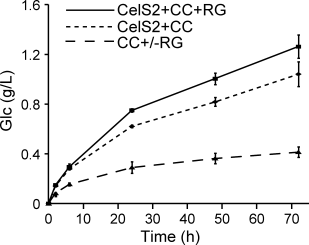Cleavage of cellulose by a CBM33 protein
- PMID: 21748815
- PMCID: PMC3190143
- DOI: 10.1002/pro.689
Cleavage of cellulose by a CBM33 protein
Abstract
Bacterial proteins categorized as family 33 carbohydrate-binding modules (CBM33) were recently shown to cleave crystalline chitin, using a mechanism that involves hydrolysis and oxidation. We show here that some members of the CBM33 family cleave crystalline cellulose as demonstrated by chromatographic and mass spectrometric analyses of soluble products released from Avicel or filter paper on incubation with CelS2, a CBM33-containing protein from Streptomyces coelicolor A3(2). These enzymes act synergistically with cellulases and may thus become important tools for efficient conversion of lignocellulosic biomass. Fungal proteins classified as glycoside hydrolase family 61 that are known to act synergistically with cellulases are likely to use a similar mechanism.
Copyright © 2011 The Protein Society.
Figures


References
-
- Merino ST, Cherry J. Progress and challenges in enzyme development for biomass utilization. Biofuels. 2007;108:95–120. - PubMed
-
- Teeri TT. Crystalline cellulose degradation: new insight into the function of cellobiohydrolases. Trends Biotechnol. 1997;15:160–167.
-
- Eijsink VGH, Vaaje-Kolstad G, Varum KM, Horn SJ. Towards new enzymes for biofuels: lessons from chitinase research. Trends Biotechnol. 2008;26:228–235. - PubMed
Publication types
MeSH terms
Substances
LinkOut - more resources
Full Text Sources
Other Literature Sources

